#Taoist Magic
Explore tagged Tumblr posts
Text
A Catalog of the Monkey King’s Magic Powers and Skills
I am happy to announce that I've finished my 177-page catalog of Sun Wukong's powers from all 100 chapters of Journey to the West. Fans of Lego Monkie Kid and Black Myth: Wukong, fanfiction writers, and artists will certainly find it useful.

#Sun Wukong#Monkey King#magic#Chinese magic#Taoist magic#Buddhist magic#magic eyes#magic hairs#Journey to the West#JTTW#Lego Monkie Kid#LMK#Black Myth Wukong#fanfiction#Chinese religion#Chinese mythology#cloud somersault#Fiery eyes
566 notes
·
View notes
Text











Twenty-eight Constellations From The Temple Of Supreme Talisman
Pottery figurines of the Twenty-Eight Constellations from the Ziwei Pavilion (紫薇閣) in Supreme Talisman (Taifu) Temple (太符觀) are quietly chatting.
The Taoist temple itself, located in Fenyang (汾陽), Shanxi, was built in the fifth year of the Jin dynasty (1200). The Jade Emperor is enshrined in the main hall. The other halls on the both sides are dedicated to the Holy Mother of Houtu (后土聖母), aka Xiwangmu, The Queen Mother of the West, and to the Five Sacred Mountains (五嶽).
The figurines, just like some of the buildings, date back to the Ming dynasty. Each is about half a meter high. Of the original number, eight have been lost over the centuries. The rest were moved to the Shanxi Museum (山西博物院).
Photo: ©雪夜魚舟
#ancient china#chinese culture#chinese art#taoism#chinese mythology#taoist practices#taoist magic#ming dynasty#jin dynasty#pottery#ceramic art#ceramic#chinese miniatures#miniature art#sculpture art#clay sculpting#miniatures#religious art#chinese temple#daoism#taoist#taoist immortal#chinese astrology#astrology#zodiac#constellations
109 notes
·
View notes
Text

#jerry abstract#techno#idm#electronic music#fringe electronica#jerryabstract#sone#friendship#totem#talisman#taoist magic#taoism#magick#sigil#typography
2 notes
·
View notes
Text
#Taoist Magic#for beginners#asian witch#asian witchcraft#taoist witch#taoist witchcraft#buddhist witch#buddhist witchcraft#buddhist magic#benebell wen#save
6 notes
·
View notes
Text
Taoist Elements In Sword Forms: A Couple Of Examples
My friend asked to give an example of Taoist element in the form. Well… For instance, the fragment involving a series of horizontal chou (抽) (or xi, 洗 as variant) with steps to both sides and dian (點) at the end (I’m using the names from Essentials Of the Wudang Sword Art (武當劍法大要)by Huang Yuanxiu, I was taught according to the manual of Li Jinglin). Continue reading Untitled

View On WordPress
#Chinese history#Chinese martial arts#Chinese sword#Chinese swordsmanship#jian#sword#tai chi#tai chi jian#taiji#Taoism#Taoist magic#Taoist rituals#Wudang sword
1 note
·
View note
Text
Do you think they'd invent youtubers in the cultivation world
#txt#'cultivation world' used loosely as in community of taoist practitioners in xianxia novels#there have been many dramas that i've watched where they communicated with eachother like through earpieces using magical arrays or#artifacts#and of course theres stuff like mirrors projecting images#sometimes they just project images into thin air#im just saying is it possible that they'd get bored enough to invent livestreaming#lol#whats up gamers we're going to defeat this demonic beast
6 notes
·
View notes
Text
We Are Time
What is time? We use time and observe time by our ability of measuring changes. To us, time is the measurement of changes. The sunrise to sunset, the full moon to the new moon, the seasons, the changing of our physical appearances as a new born baby to an old person in the grave, the time between each heartbeat, and so on.
Those are just our measurements of the observations we notice of changes. We do not realize that our brain time stamps each incoming sensory signal so that they can be accurately matched to the same event: seeing, touching, hearing, and hitting a ball all have sensory signals traveling at different speeds reaching the brain at different times. Otherwise, we would be in a constant state of confusion.
We also do not realize that our vision of receiving photons, all come at different time intervals from the same source. This then creates the perception of length, width, and height. When we see a building, or a tree, or a stick, we think we are seeing all at once the entire building, tree, or stick. In fact, thousands of photons from each different point and location of the building, tree, or stick, from the bottom, from the middle, from the top, are reaching our brain at different time intervals. Our brain just combines the bottom, middle, and top sections together as one moment. We then see the building as one thing at one moment, and not thousands of moments and of sections with each section and each moment having a photon reaching our brain at slightly different time intervals. So when we see width, length, and height, we are seeing time! But, that still is not the substance of time. It is still a measurement of our ability of observation!
We are time. The substance of time is us! Time is not out there. Time is us! What does this mean? Can I break this down to more elemental insights and understandings? What is the substance of time! What has been given to me for me to be time? How am I time? What makes me and you to be time itself! Time is me, and me is time! How can this be?
#consciousness#atheist#mind#meditation#buddhism#spiritual#buddha#atheism#buddhist#hinduism#time#perception#simulation#gnostic#mysticism#mystical#magic#reality#enlightenment#heaven#truths#daoist#dao#taoist#taoism#qabalah#kabbalah
2 notes
·
View notes
Text

!! BYAKUREN AT RISK !!
#Muse Byakuren#AKA being at home at the temple or hanging out with the taoists or-#Lets just say her body enhancing magic comes in handy
3 notes
·
View notes
Text
"Is that so?" said Wukong. "Let me try the iron on you!"
You deceive Sun Wukong?! You don't give him the martial clothes he had so politely asked for?!?
Oh, oh! Golden Hooped Iron Rod to the head for the Old Dragon King, Golden Hooped Iron Rod to the head for the Old Dragon King for a thousand years!
#And then the Old Dragon King had to call his brothers to give him cool clothes because there is a magical immortal taoist monkey#With a Golden Rod that weights thirteen thousand five hundred pounds throwing a tantrum at his door#journey to the west daily#Jttwdaily#journey to the west#sun wukong
5 notes
·
View notes
Text
Ascending and descending lines found in various types of talismanic calligraphy are another reference to the invisible lines of contact between celestial spirits above and terrestrial beings below. This concept of linear contact is very close to the shamanistic symbol of the Tree (axis mundi) which was said to be the home of the spirits permitting ascent to the various heavens or descent to our world. The lines occur with surprising regularity in all kinds of talismans.
Laszlo Legeza, Tao Magic: The Secret Language of Diagrams & Calligraphy (1975)
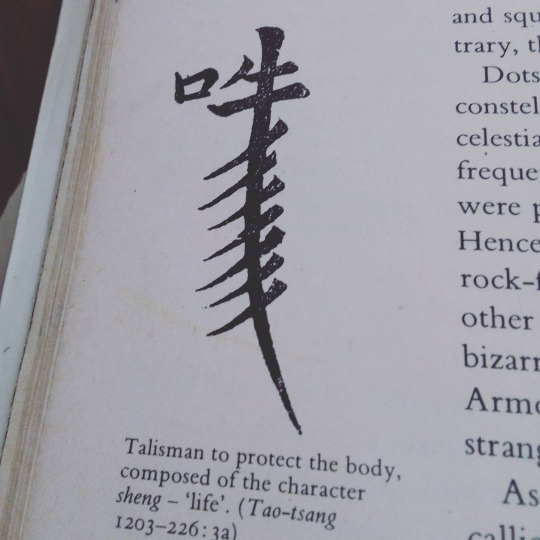
2K notes
·
View notes
Text
Oh no ...
Someone aware of my recently-finished catalog of Sun Wukong's powers and skills indirectly requested that I make a list of powers from Fengshen yanyi (封神演義, c. 1620).
But I don't have the mental energy for it. Plus, I am not as familiar with the book as I am JTTW. I'll pass the torch onto someone else ... COUGH @ryin-silverfish COUGH.

#journey to the west#jttw#fengshen yanyi#fsyy#list of powers#magic powers#twitter#sun wukong#monkey king#magic#chinese magic#taoist magic#daoist magic#buddhist magic#pass the torch
64 notes
·
View notes
Text








Ancestral Hall of the Tiger Talisman in Fujian
One of those architectural gems that are scattered throughout the Chinese countryside: the Ancestral Hall of the Tiger Talisman (虎符祖���) aka Huyan Ancestral Hall (虎岩祖殿) or Hufuyan (虎符岩) in Nanfeng (南豐村), Xinqiao, Fujian.
Built in the Song dynasty and rebuilt in the 16th year of Jiajing in the Ming dynasty (1537), the complex covers an area of about 1800 square meters. This temple is dedicated to the Taoist Leifa deity Zhang Shengjun (張聖君), the Master of Five Thunders. The papers with talismanic inscriptions are stuck under the ceiling.
Photo: ©劉江嶺
#ancient china#chinese culture#chinese art#chinese architecture#ming dynasty#song dynasty#wooden architecture#wooden buildings#chinese mythology#taoist magic#taoism#taoist practices#chinese customs#taoist sorcery#taoist#chinese folk religion#chinese temple#Taoist temple#religious art#temple architecture#thunder rites#Leifa#ancestral hall#ancestral shrine
99 notes
·
View notes
Text

#jerry abstract#modern occcult musick#jerryabstract#typography#totem#graphic design#sigil#talisman#magick#taoist magic#taoism#friendship
1 note
·
View note
Text
[Hanfu · 漢服]Chinese immortal Hanfu <电母/Mother of Lightning> Based On Yuan Dynasty Taoist Temple Mural<永乐宫/Yongle Palace>
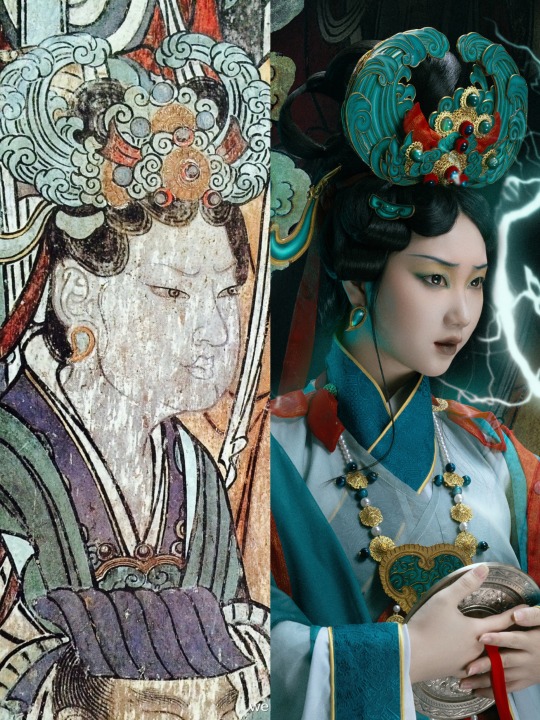
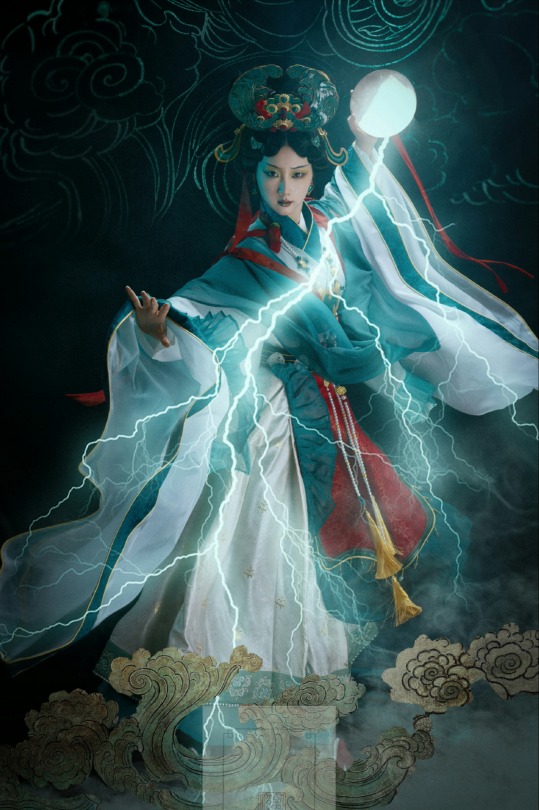
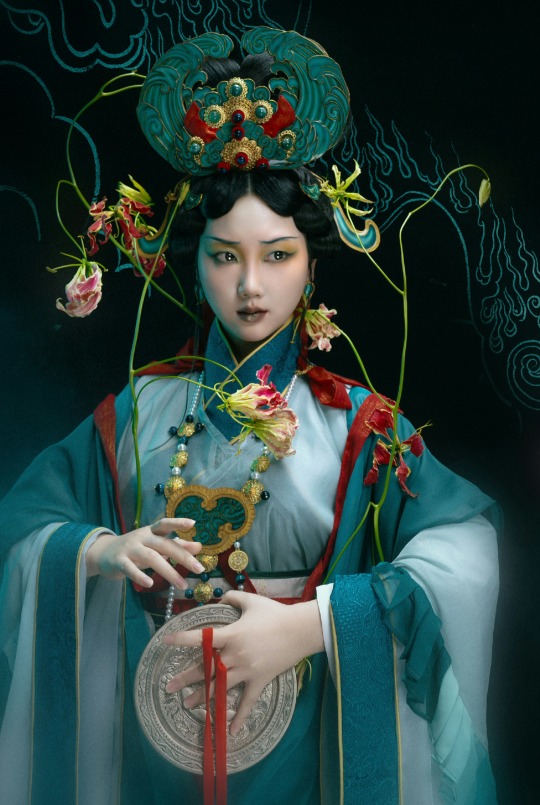
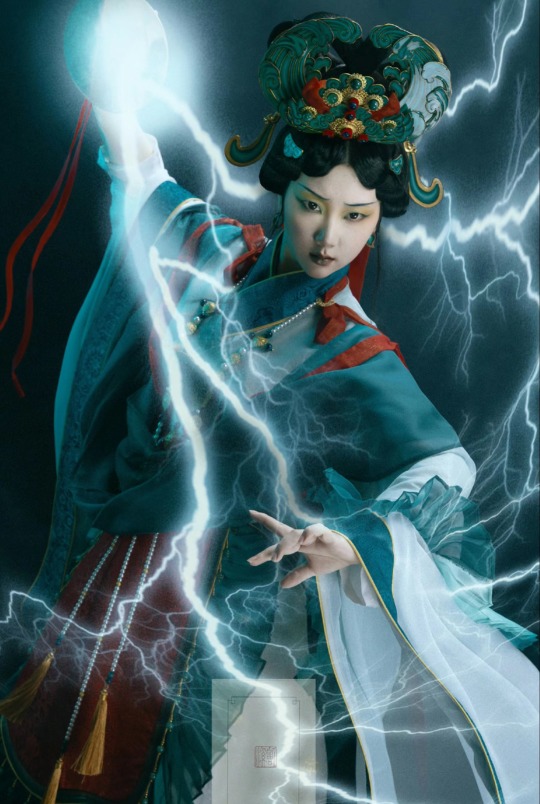
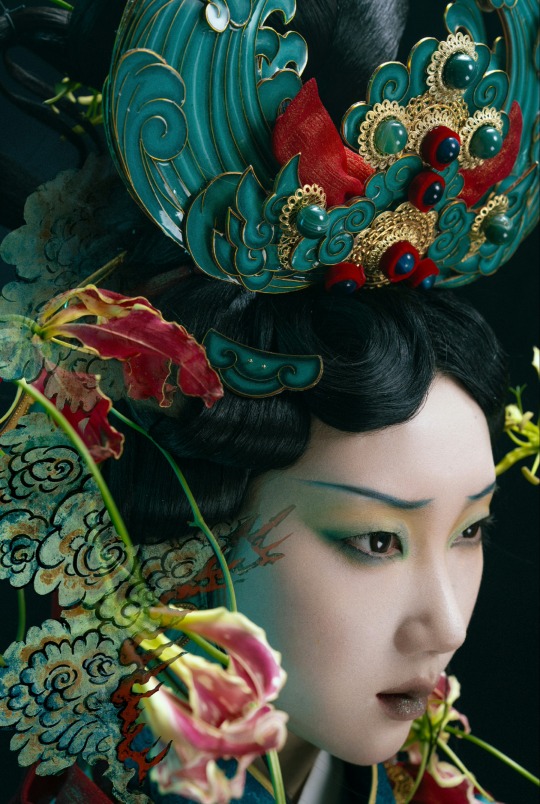

【Historical Artifacts Reference 】:▶ China Yuan Dynasty Taoist Temple 永乐宫/Yongle Palace Mural<电母/Mother of Lightning>

⚡【电母/Mother of Lightning】⚡
电母/Dianmu (Chinese: 電母; pinyin: Diànmǔ; lit. 'Mother of Lightning'), also known as Leizi, is the Chinese goddess of lightning, who is said to have used flashing mirrors to send bolts of lightning across the sky.
She is married to Leigong/雷公, the god of thunder. She is one of the gods who work together to produce the phenomena of thunder. Other companions are Yun Tong (Yún Tóng, 云童, lit. the "Cloud Youth/Kid"), who whips up clouds, and Yu Shi/雨师 ("Rain Master") who causes downpours by dipping his sword into a pot. Roaring winds rush forth from a type of goatskin bag manipulated by Fengbo/风伯 ("Earl of Wind/Wind Uncle"), who was later transformed into Feng Po Po ("Old Lady Wind").
Legend
Dianmu was once a human, who lived with her mother. One day, she was dumping rice husks, because they were too hard for her mother to eat. When the short-tempered thunder god Leigong saw her dumping the husks out, he thought she was wasting food, so he killed her. When the Jade Emperor found out, he was infuriated at Leigong's careless murder. The Jade Emperor revived Dianmu, making her a goddess. Dianmu was made to marry Leigong, who took on the responsibility of caring for her. Dianmu's job is now to work with Lei Gong. She uses mirrors to shine light on the Earth, so Leigong can see who he hits and makes sure they aren't innocent. This is why lightning comes before thunder.
In other depictions
Dianmu also appears in Wu Cheng'en's late 16th-century novel, the Journey to the West; she appears during the events of the Slow Cart Kingdom (車遲國, Chechi), where three 'Animal Strength/Power Immortals', "Tiger Strength", "Deer/Elk Strength" and "Goat/Antelope Strength", three demons who disguised themselves as Taoist magicians to deceive the King of the Kingdom of Chechi, by means of having ended a seemingly-endless drought through the means of a legitimate magic tablet that can control the weather by summoning gods in control of various aspects of the weather, including Dianmu, accompanied by Yún Tóng (云童, lit. the "Cloud Youth"). Once Sun Wukong interrupts the summons, Dianmu and her fellow weather deities help the Buddhists instead of the demons in their rain-making competition.
————————
📸Photography post-production :@小何力
👗Hanfu & 👑Crown:@雁鸿Aimee
💄 Makeup:百丽 (临溪摄影)
👭Model:@清音音音音
🔗 Weibo:https://weibo.com/1615560544/O267AzTqM
————————
#chinese hanfu#immortal hanfu#电母/Mother of Lightning#Chinese mythology#hanfu#hanfu accessories#hanfu_challenge#chinese traditional clothing#china#chinese#hanfu girl#hanfu fashion#chinese history#china mythology#chinese style#漢服#汉服#中華風
459 notes
·
View notes
Text
chinese daoshi道士/taoist make magic weapons (this one is coin originated hundres years ago) with strong power to drive away evil spirits
#china#zhongyuan festival#xhs#noticing how op stabilized the flame of the candle#do not imitate#the action can be only operated by the professional outsiders will get theselves into trouble if they try#just like a previous post that a girl summoned thunder and lighting and wind and rain
221 notes
·
View notes
Text
the void state through the context of asian philosophy
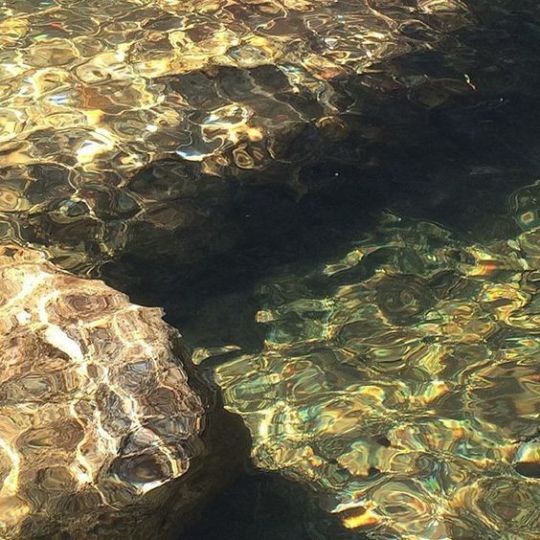

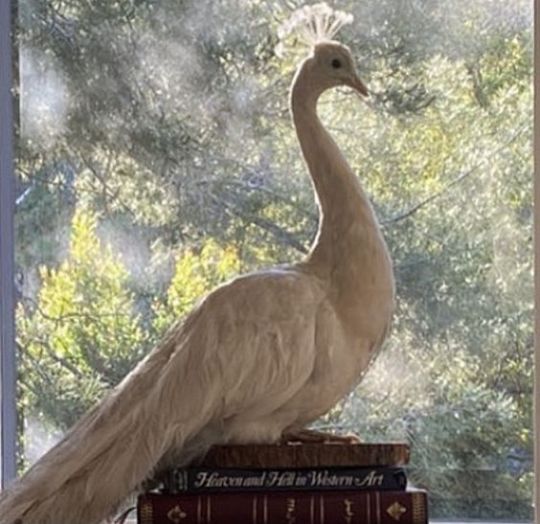

How often does one hear about the void state? Many people probably think it doesn’t exist because the idea of instant ‘manifestation’ is too good to be true. The fundamental realm of our world taught us that suffering is inevitable, and success can only be achieved through physical hard work. Sometimes, the idea of exquisite comfort and abundance of wealth hangs above people’s heads like a bait, oftentimes those that climb the ladders, falls off and never to return again. If it was fake, there wouldn’t be so many similarities in philosophy all across the world, some stretches back to ancient civilizations. The void state has many names/terms depending on each culture interpretation, but it is always referred to the state of stillness. I used to be skeptical of anything metaphysical related, but if you really want to change your life, I’d advise you to drop all of those doubts just for several minutes. Remember your roots, just remember.

In Taoism, there is a concept called ‘wuji’ (無極) which directly translated to ‘without limit’ or ‘without roof’. Wuji is represented by a blank circle and described as the state of unmanifest, a stillness, infinite ‘no-thing’, and a primordial universe. Many Taoist scholars described ‘wuji’ as a ‘good night sleep’ where all negative and positive emotions cease to exist, many believers of Taoism stated that the world was once in the ‘wuji’ state. Since it is boundless and an infinite universe, ‘wuji’ must exist in order for movement and manifestation to arise. This state is taught in many forms of Chinese martial art, oftentimes requires deep concentration to fully ‘enter’ (I don’t like this word because ‘wuji’ isn’t a magical place, it literally exists within you, it needs you to exist. You are the movement and manifestation). Overall, martial artists used this to relax mentally and physically, it’s actually a meditative state. In ‘wuji’, you have the potential to ‘move’ and become ‘something', as it is a pre-existential state.
Another state of stillness can be seen in Buddhism is the Śūnyatā or suññatā (voidness, vacuity or emptiness) Buddhist philosophers even refers to is ‘The Void’ where the essence of the soul is empty, it is ‘the synonym of that which has no cause, that which is beyond thought or conception, that which is not produced, that which is not born, that which is without measure.’ ‘Sunyata’ is a composition of ultimate reality and the release of attachment. The Buddha found true enlightenment when he realized ‘emptiness’. He freed himself from all of the suffering and dissatisfaction of the Earthly world. In ‘sunyata’, every entity is interconnected with a blankness, the concept explains that the universe's ever-changing and empty nature allows for the creation and destruction of all things. To reach the state of ‘sunyata’ or the great void, one must have great concentration and tread gently, avoiding forcing their way in.

That was a lot of researching and summarizing but I love to share my knowledges with you. As you can see, the void state is not anything new. In-fact the concept is much older than we think! I hope this post showed you new insights and please stop doubting the void's existence. It lives within you, it is literally a part of you.
#dividers by fairytopea / credit in tags if used#loa blog#loa tumblr#loassumption#void state#law of assumption#manifesation#neville goddard
371 notes
·
View notes